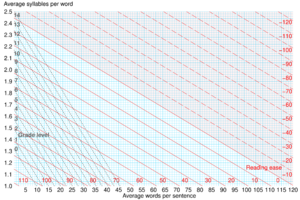Flesch–Kincaid readability tests facts for kids
The Flesch–Kincaid readability tests help you figure out how easy or hard a piece of writing is to understand. They are made for text in English.
There are two main tests: the Flesch Reading-Ease and the Flesch–Kincaid Grade Level. Both tests look at how long words are and how long sentences are. But they use these measurements in slightly different ways.
If a text gets a high score on the Reading Ease test (meaning it's easy), it will usually get a low score on the Grade Level test (meaning it's for younger readers). Rudolf Flesch created the Reading Ease test. Later, he and J. Peter Kincaid developed the Grade Level test for the United States Navy.
Contents
History of Flesch-Kincaid Tests
The Flesch–Kincaid (F–K) reading grade level test was created in 1975. J. Peter Kincaid and his team developed it for the U.S. Navy. They also studied how to make technical information easier to read and understand.
The Army first used the F–K formula in 1978. They used it to check how difficult their technical manuals were. Soon after, it became a standard for the U.S. Military.
Some U.S. states, like Pennsylvania, now require legal documents to be easy to read. For example, automobile insurance policies must be written at a ninth-grade reading level or simpler. This means a 14- to 15-year-old should be able to understand them.
Understanding Flesch Reading Ease Scores
The Flesch Reading-Ease test gives you a score that shows how easy a text is to read. Higher scores mean the text is easier to understand. Lower scores mean it is more difficult.
The test looks at the total number of words, sentences, and syllables in a passage. It then uses a formula to give a score.
Here's what the scores generally mean:
| Score | School Level (US) | What it means |
|---|---|---|
| 100.00–90.00 | 5th grade | Very easy to read. An average 11-year-old can easily understand it. |
| 90.0–80.0 | 6th grade | Easy to read. Like everyday conversations. |
| 80.0–70.0 | 7th grade | Fairly easy to read. |
| 70.0–60.0 | 8th & 9th grade | Plain English. Most 13- to 15-year-olds can understand it. |
| 60.0–50.0 | 10th to 12th grade | Fairly difficult to read. |
| 50.0–30.0 | College | Difficult to read. |
| 30.0–10.0 | College graduate | Very difficult to read. Best for university graduates. |
| 10.0–0.0 | Professional | Extremely difficult to read. Best for experts in a field. |
For example, Reader's Digest magazine usually scores around 65. Time magazine scores about 52. A typical written assignment from a 12-year-old (grade six) might score 60–70. The Harvard Law Review often scores in the low 30s.
The highest possible score is 121.22. This happens if every sentence has only one one-syllable word. For example, "The cat sat on the mat." scores 116.
The U.S. Department of Defense uses this test for their documents. Also, some states like Florida require insurance policies to have a Flesch reading ease score of 45 or higher. Many popular computer programs like Microsoft Office Word include this test.
Flesch–Kincaid Grade Level Formula
The "Flesch–Kincaid Grade Level Formula" is widely used in education. It gives a score that matches a U.S. grade level. This helps teachers, parents, and librarians choose books and texts that are right for a student's reading level.
The score can also mean how many years of education are generally needed to understand the text. This is useful if the score is higher than grade 10. This formula also looks at the number of words, sentences, and syllables.
For example, the sentence "The Australian platypus is seemingly a hybrid of a mammal and reptilian creature" scores about 11.3. This means it is written at an 11th-grade reading level.
The two Flesch-Kincaid tests use different ways to weigh sentence length and word length. So, their scores cannot be directly compared or converted into each other. The grade level formula focuses more on sentence length than word length.
The lowest possible grade level score is -3.40. Green Eggs and Ham by Dr. Seuss is a good example of a very easy book. It has a grade level of about -1.3. Most of its words have only one syllable.
Limitations of Readability Tests
Readability formulas were first made for school books. They might not always be perfect for every situation. They don't consider differences between readers. They also don't look at how the content, layout, or helpful features (like headings) affect understanding.
For example, the strange sentence "Cwm fjord-bank glyphs vext quiz." gets a reading ease score of 100. It also gets a grade level score of 0.52. This is despite having very unusual words that most people wouldn't know.
See also
 In Spanish: Prueba de legibilidad de Flesch-Kincaid para niños
In Spanish: Prueba de legibilidad de Flesch-Kincaid para niños


